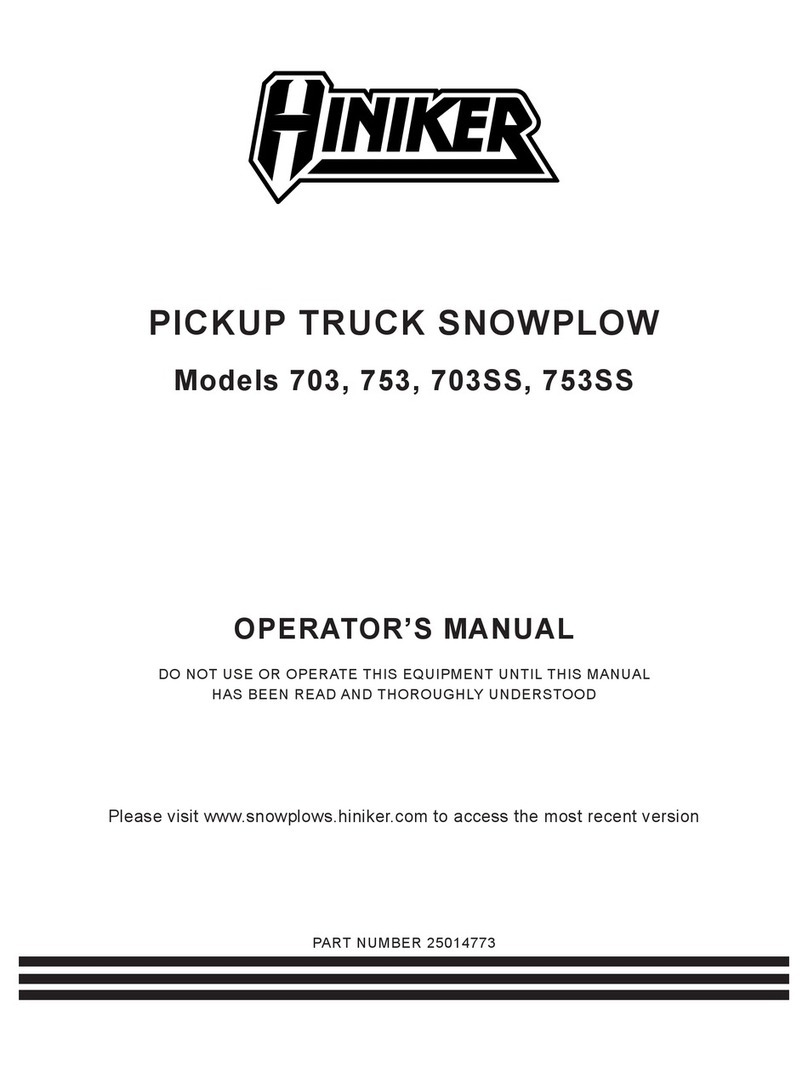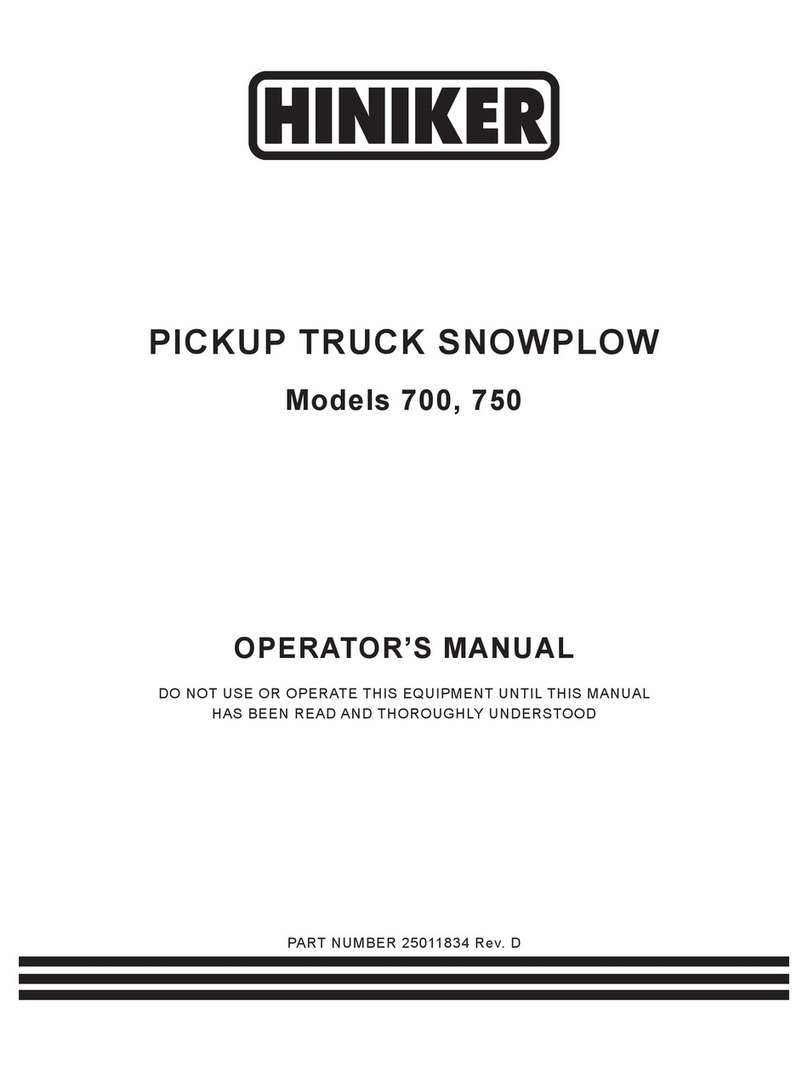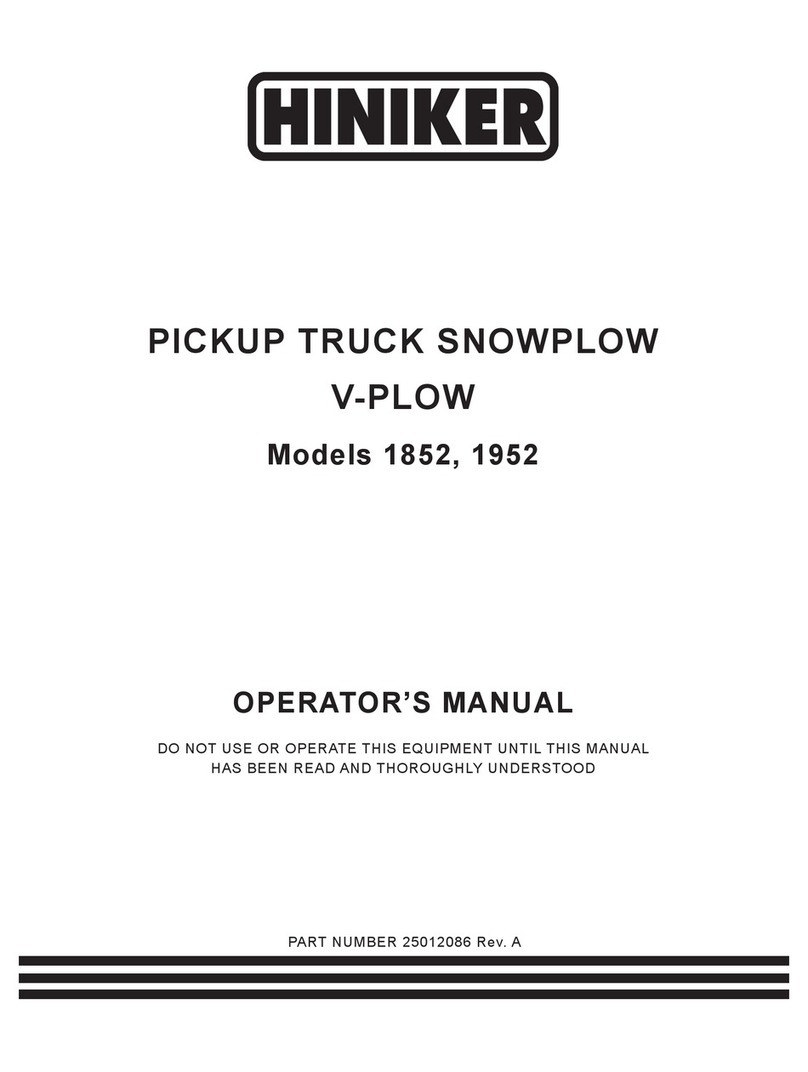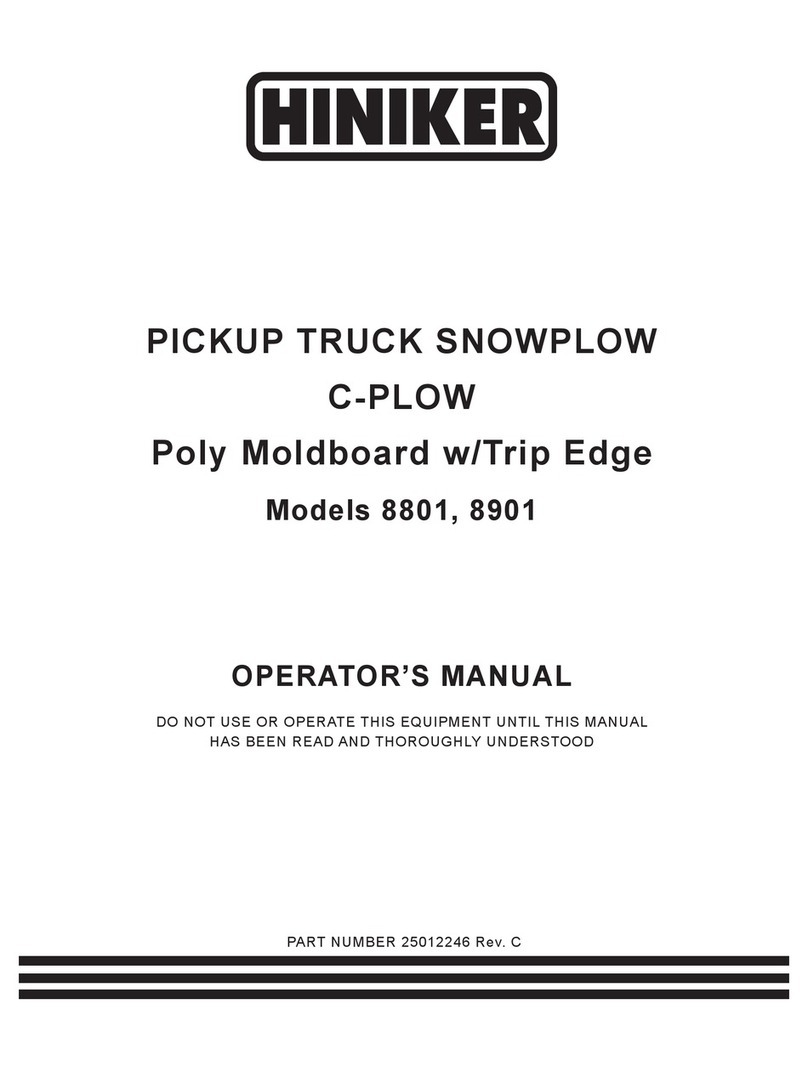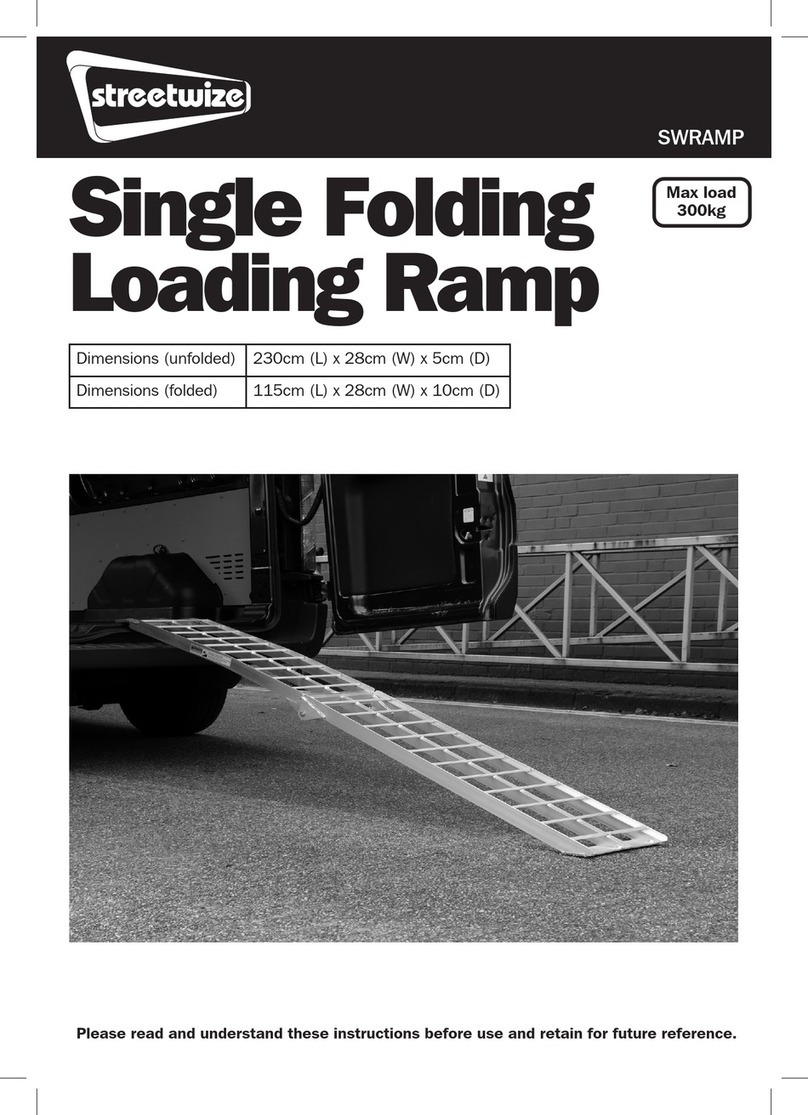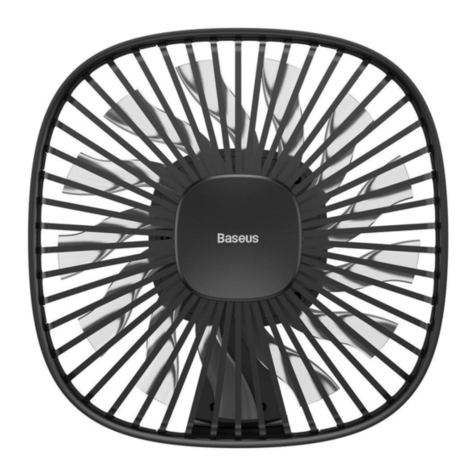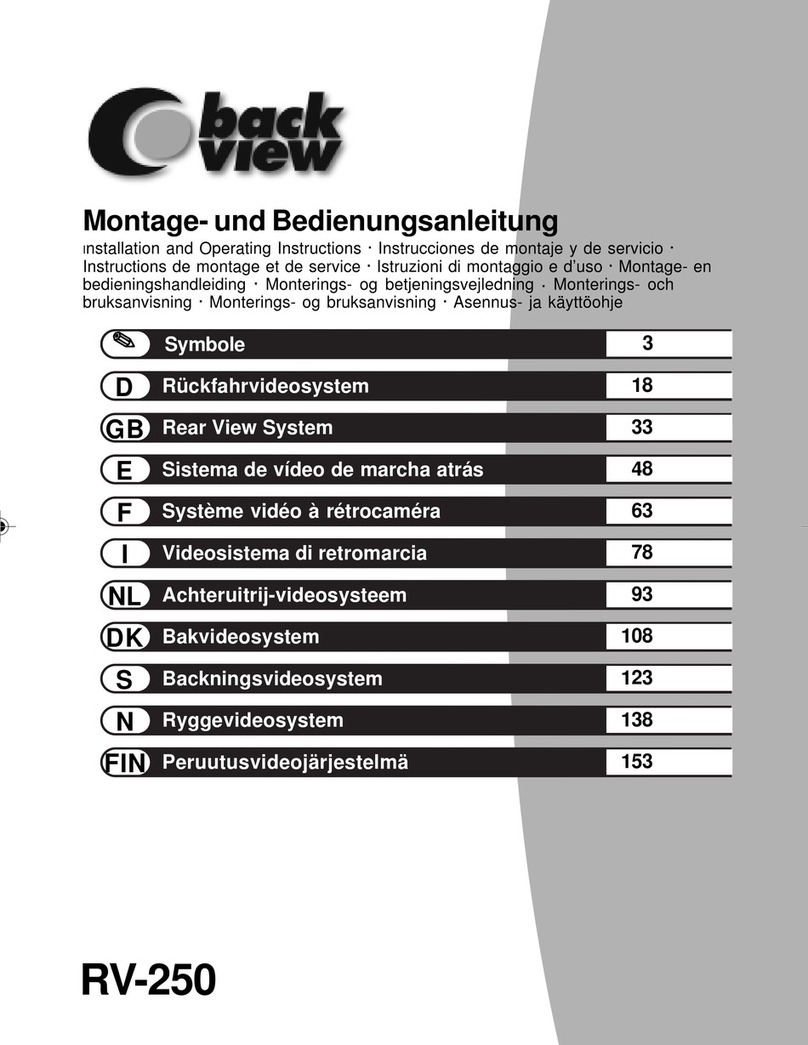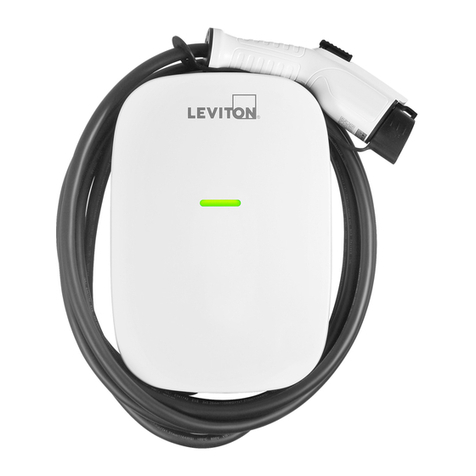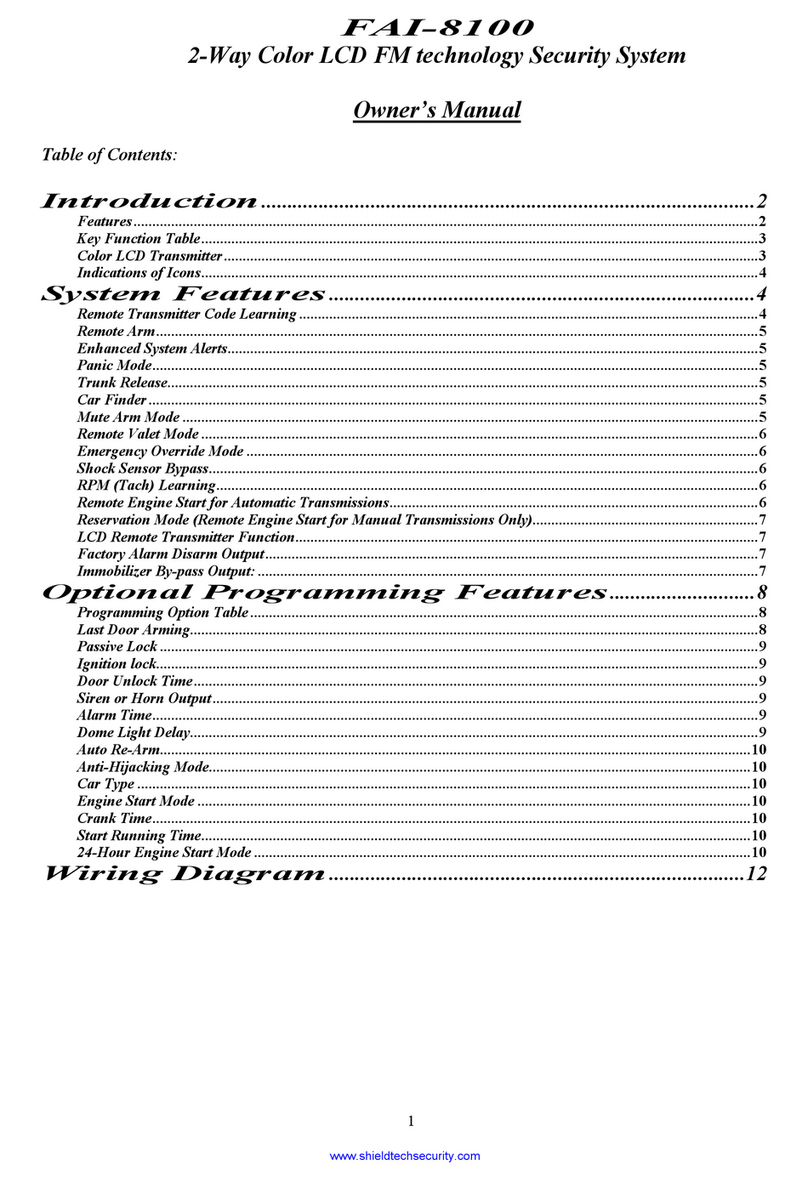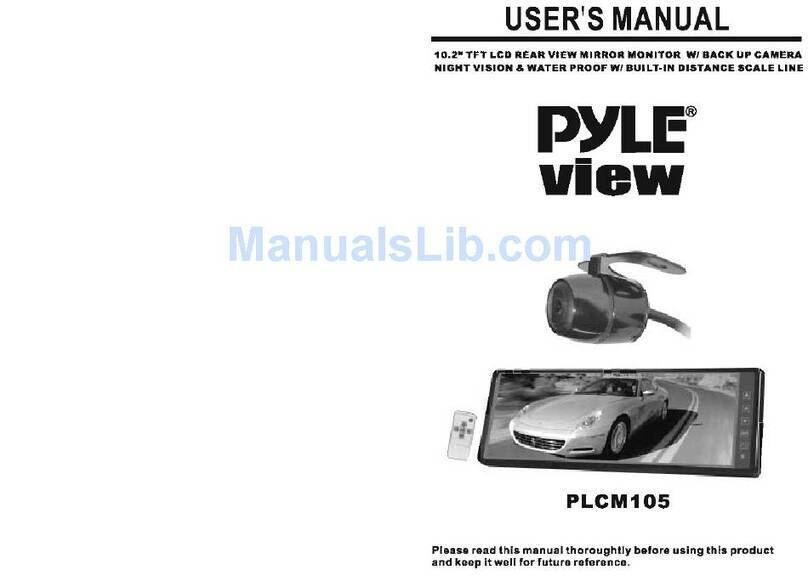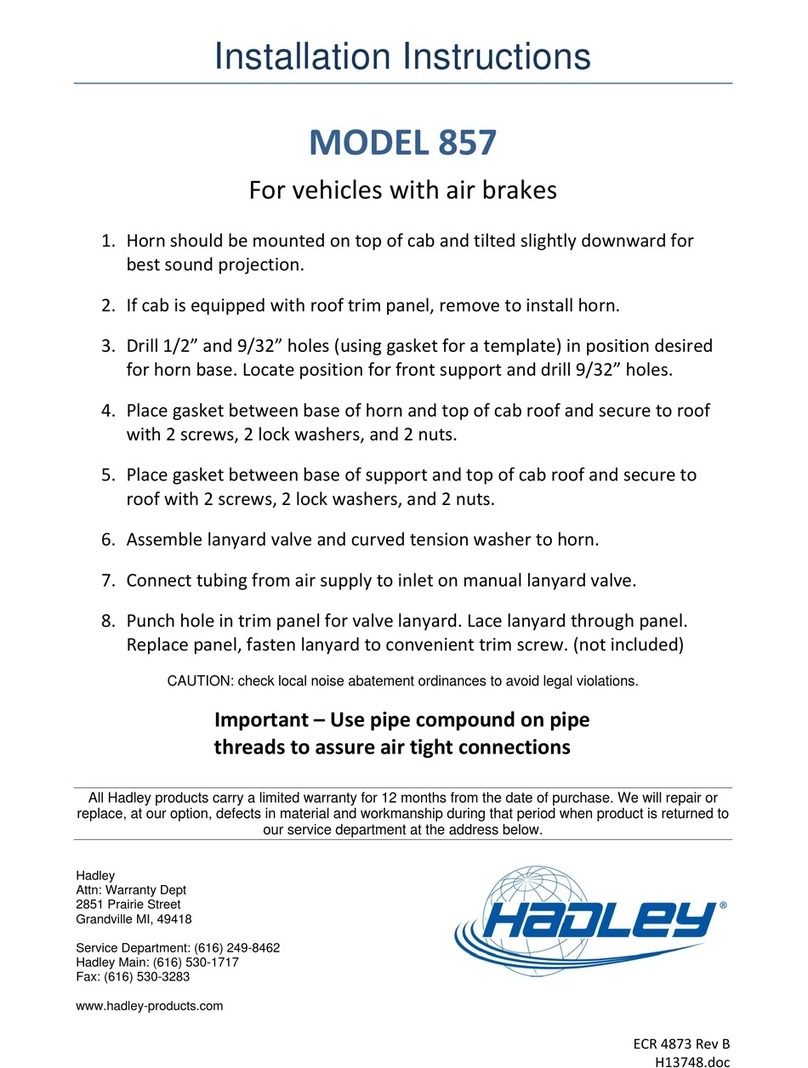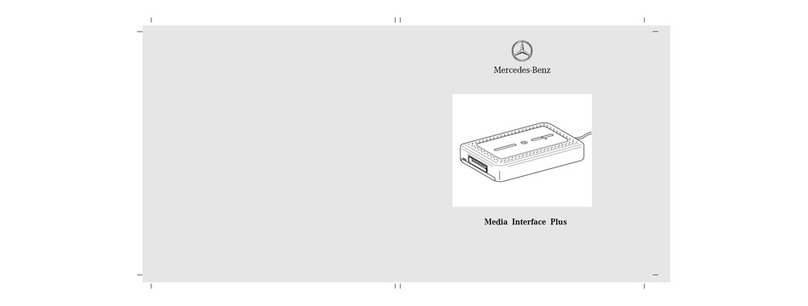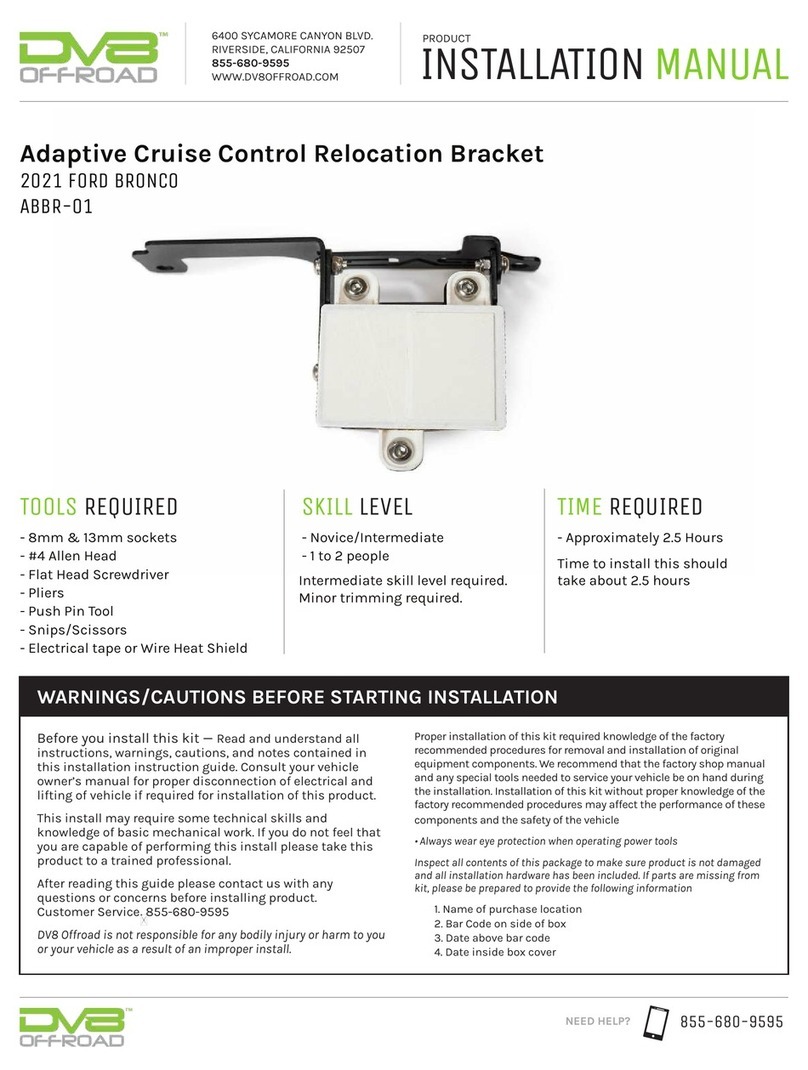Hiniker 9850 User manual

PICKUP TRUCK SNOWPLOW
V-PLOW
Models 9850, 9950
OPERATOR’S MANUAL
DO NOT USE OR OPERATE THIS EQUIPMENT UNTIL THIS MANUAL
HAS BEEN READ AND THOROUGHLY UNDERSTOOD
PART NUMBER 25012268 Rev. C


TABLE OF CONTENTS
TO THE PURCHASER.................................................................................................................. 2
SAFETY......................................................................................................................................... 3
OPERATING PROCEDURES....................................................................................................... 4
TROUBLE SHOOTING ................................................................................................................. 9
MAINTENANCE ...........................................................................................................................11
ASSEMBLY ................................................................................................................................. 13
SYSTEM CHECK-OUTAND JOYSTICK CONFIGURATION ..................................................... 24
HEADLAMPAIMING PROCEDURE........................................................................................... 25
SPECIFICATIONS....................................................................................................................... 30
WARRANTY................................................................................................................................ 31
Table of Contents 1
25012268RevC 3/10 Hiniker/25012268RevC

TO THE PURCHASER
2 To The Purchaser
This product is designed and manufactured to
give years of dependable service when properly
maintained and used for the purpose for which
it is intended. Never allow anyone to operate
this equipment until they fully understand the
complete contents of this manual. It is the re-
sponsibility of owners who do not operate this
equipment to ensure the operator is properly
instructed and understands the contents of this
manual. It is also the owner’s responsibility to
ensure that anyone operating this equipment is
mentally and physically capable of so doing.
Important information is contained in this manu-
al to help ensure safe and efficient operation.
If you have any questions about this manual, or
the equipment discussed herein, contact your
Hiniker dealer.
This is a safety alert symbol. It alerts
an operator to information concerning
personal safety. Always observe and
heed these instructions, otherwise death or
serious injury can result.
All references to Left or Right are defined as
viewing the plow from the cab of the truck.
Instructions for raising and lowering the plow
refer to the joystick controller as received from
the factory. The raise and lower functions may
be reversed to suit the preference of the opera-
tor by following the instructions on page 24 for
switching the controller joystick and face plate.
This Operator’s manual is shipped with this
equipment. Contact your Hiniker dealer for ad-
ditional copies.
Always obtain original Hiniker service parts.
Substitute parts could adversely affect equip-
ment performance and warranty.
CheckthatyourdealerhasforwardedtheHiniker
delivery report form along with the plow identifi-
cation number because it helps maintain maxi-
mum service and warranty benefits. This does
not put you on any mailing list, and information
thereon is not available to others.
Your snowplow’s identification number decal is
at location (1) in the following illustration.
DWG. NO. 5993
Record the following information for later ref-
erence when obtaining service parts:
Purchase Date
Purchaser’s Name
Dealer’s Name
Machine I.D. No.

This is a safety alert symbol. It alerts
an operator to information concern-
ing personal safety. Always observe
and heed these symbols and instructions,
otherwise death or serious injury can result.
Operator safety is a principle concern in equip-
ment design and distribution. However, many
accidents occur because a few seconds of
thought, and a more careful approach to han-
dling, were ignored. Accidents can be avoided
by knowing and following the precautions cited
in this manual.
GENERAL SAFETY
1. Read this manual thoroughly. Make sure
the operator understands it and knows
how to operate this equipment safely. This
equipment can kill or injure an untrained or
careless operator and bystanders. If you
sell this equipment, ensure the new owner
acknowledges receipt of this manual.
2. This plow is intended for plowing snow
only. Plowing gravel, rocks, etc., or using
the plow for any purpose other than plowing
snow could result in harm to the operator or
bystanders or cause damage to the plow or
vehicle, and will void the warranty.
3. Do not service or otherwise handle a plow
in the raised position unless it is securely
blocked against unexpected falling. Like-
wise, when servicing a plow with the wings
extended, block wings to prevent unexpect-
ed wing movement due to accidental loss of
hydraulic pressure or cylinder removal.
4. Do not attempt to handle or service this
equipment, or direct others to do the same,
unless you know how to do it safely and
have the proper tools for the job.
5. Keep hands, feet, hair, and clothing away
from moving parts.
6. Do not alter the equipment to the extent of
compromising safety or performance.
SAFETY
BEFORE OPERATION
1. Discipline yourself to visually check for
worn, damaged or cracked parts before
starting use. Replace these with genuine
Hiniker parts.
2. Escaping hydraulic oil under pressure can
penetrate the skin, causing serious injury.
Do not use your hand to check for leaks.
Use a piece of paper or cardboard to nd
suspected leaks.
Tighten all connections before pressurizing
hydraulic lines.
If uid is injected into the skin, get medical
attention immediately to prevent serious in-
fection.
3. Check all controls and operating functions
of the machine in a safe area before start-
ing to work.
DURING OPERATION
1. Always wear seat belts when operating a
motor vehicle.
2. Ensure everyone is clear of the machine,
especially away from blind areas of the op-
erator, before starting, actuating hydraulics
or operating this equipment.
3. Do not plow snow at excessively high
speeds.
4. Avoid hitting objects that will damage your
plow or truck.
5. Set the brakes and stop the truck’s engine
before adjusting or servicing your plow.
AFTER OPERATION
1. Park the plow on a solid, level surface. Fully
collapse the lift cylinder and use the stop
plate, as described on page 7, before un-
hitching the plow to prevent the frame from
falling forward.
Safety 3

OPERATING PROCEDURES
ATTACHING THE PLOW
Attachmentprongsonthetruckshouldbemount-
ed such that the bottom edge of the prongs mea-
sure about 10 inches above the ground. Prong
receivers on the plow frame should remain par-
allel to the ground and at the correct height by
fully retracting the lift cylinder with the upper lift
links and bracing the frame with the stop plate
before removing the plow from the truck (see
“Removing the Plow”). Ideally, the prongs on
the truck should lift the plow frame slightly when
driving into the plow for attachment.
Powdered graphite applied on the prongs will
help the plow slide on and off more easily.
Check that prongs are in line with the receivers
before slowly driving into the plow. Set the park-
ing brake in the truck to prevent it from creeping
back out from the receivers.
DWG. NO. 5995
Remove the tab lock pin from the parking stand
index plate to raise the stand to its highest posi-
tion. Reinstall the pin in the plate for transport.
Pull the latch handle into the clevis on the lift
frame to force the sliders through the notches
in the prongs and receivers. Check that both
sliders are fully engaged. Pin the handle in the
clevis with its klik pin. Failure to pin the handle
in place may allow the plow to fall off the truck.
Handle Pinned With Plow On Truck DWG. NO. 6003
Plug in the three electrical connectors between
the plow and the truck after latching the plow.
The alignment tab on the 10-pin receptacle will
mate with the slot in the mounting plate on the
truck grill to ensure proper connection.
Alignment Tab and Slot DWG. NO. 5232
Check that the plow headlamps and turn signals
are operational, and headlamps are aimed cor-
rectly. Test the lift and angling cylinders in a safe
area before using the plow.
To make alignment of the plow easier in the fu-
ture, mark a point on the back of the LH head-
lamp, a point on the hood near the front of the
truck and a point on the windshield that are in
line when you are seated behind the steering
wheel. Line up these three points when driving
into the plow.
4 Operating Procedures

THE JOYSTICK CONTROLLER
The joystick control box has slide switches for con-
trolling power to the snowplow and for switching
from the truck headlights to the headlights on the
plow. The joystick controller raises and lowers the
plow and angles the blade left or right. Two push
buttons on the box are used to extend both wings
to the scoop position or retract both wings to the
V-position.
NOTE: Drawings 4181 and 4163 show the raise
and lower functions of the joystick controller as
received from the factory. Functions may be re-
versed to suit the preference of the operator by
following the instructions on page 24 for switching
the controller joystick and face plate.
The vehicle’s electrical power must be turned on
before the control box will function.
VEE
Joystick Control Box DWG. NO. 4181
Place the on/off switch on the joystick control box
in the “On” position to supply power to the snow-
plow. A green light will indicate power is on.
Move the headlight slide switch on the control box
to the “Plow” position to change from the truck
lights to the snowplow lights. Activate high beam/
low beam and turn signal/parking lamps from the
truck as you normally would without the plow at-
tached.
NOTE: When removing the plow, remember to
place the headlight switch in the “Truck” position
to return power to the truck’s headlights.
Raise and lower the plow by moving the joystick
forward and backward. Hold the plow at an inter-
mediate height by releasing the joystick from the
“Raise” position when the plow reaches the de-
sired height. Moving the joystick to the “Lower” po-
sition will lower the blade to the ground and allow
the plow to “Float” along the contour of the ground
while plowing snow. The green light on the control
box will turn yellow to indicate the plow is in the
oat mode. Momentarily moving the joystick to the
“Raise” position will remove the plow from the oat
mode and the yellow light will return to green.
Raise the blade before working the wing functions
of the plow to avoid resistance from the ground.
Move the joystick left or right to angle the blade to
that side. Push the left button on the control box to
extend both wings into the scoop position. Push
the right button to retract both wings into the V-
position.
To hold the wings in position straight across the
truck, start with the plow in the V-position, then
push the left button on the control box to move
both wings forward together and release the but-
ton when the wings are at the desired position.
TRANSPORTING THE PLOW
The extra weight of the snowplow on your truck
will impair handling response and increase braking
distance. The plow will also block some airow to
the vehicle’s cooling system, possibly causing the
vehicle to overheat. Therefore, it is important not
to exceed speeds above 45 mph when the plow is
attached. Remove the plow if you must drive your
truck for long distances when the temperature is
warm.
Fully raise the plow, then move the wings into the
V-position before driving. Transport the plow with
power to the joystick control box switched off to
prevent accidental lowering of the plow. Never
adjust the blade height or angle the wings while
transporting the plow.
Operating Procedures 5

PLOWING SNOW
WARNING: Always wear a seat belt when
plowing snow. Sudden contact with a hid-
den object can result in serious personal
injury.
Inspect areas to be plowed before snowfall for poten-
tial hazards, and mark obstructions with stakes that
will be seen when snow covers the ground. Identify
any emergency equipment and utility outlets that
may need to be cleared in the event of a storm. Pre-
pare a plan beforehand for clearing snow from tight
or enclosed areas and locate sites for stacking snow.
Level the plow in the scoop position by loosening
the hardware through the front of the pushframe and
through the diagonal braces to allow the plow to set-
tle to the ground. Retighten the hardware once the
plow is level.
DWG. NO. 5996
Adjust the skids at the back of the moldboard ac-
cording to the surface to be plowed. The bottom of
the skids should be about 1/2” below the cutting edge
when plowing gravel roads or lots. Skids should be
even with the cutting edge on hard surfaces such as
asphalt or concrete.
Always plow snow as it is accumulating. Wet snow
may weigh about12 pounds percubic foot. The weight
of snow being pushed by your plow may increase to
several tons.
Allowing snow depth to grow to unmanageable lev-
els can cause difcult removal problems and can be
costly in terms of wear on equipment.
WARNING: Serious personal injury can re-
sult from plowing at excessive speeds, as
well as costly damage to equipment and
property, if an obstruction is encountered while
plowing. Do not exceed 10 mph while plowing.
Plow snow in the lowest truck gear to transfer maxi-
mum power to the cutting edge. Clear areas in front
of buildings rst. Backdrag snow away from buildings
by driving to the building with the plow raised, then
dropping the blade to pull snow away. Push snow to
outer edges of the lot after snow is away from build-
ings.
Begin clearing large lots by putting the plow in the V-
position and creating a single path. Roll snow to the
outer edges of the lot by taking successive passes
with the blade angled, or put the plow in the scoop
position and push snow to the end of the lot. Break
up hard snowbanks with the plow in the V-position.
When plowing very deep snow, it may be necessary
to raise the blade and shear off layers of snow until a
working area is cleared. Work small areas in multiple
passes to push snow to outer edges. Generally, 6
inch snow can be plowed with the entire blade width;
9 inch snow with 3/4 of the blade width; 12 inch snow
with 1/2 of the blade width. Local conditions will de-
termine how much work can be done before stalling
or getting stuck.
PARKING
Lower the plow to the ground when parking your
truck for a long period of time with the plow attached.
Place the on/off switch in the “off’ position to prevent
the plow from drawing power from the truck battery.
The plow’s power unit may continue to draw electri-
cal current from the truck battery if the control switch
is left on; possibly resulting in insufcient charge to
start the truck.
REMOVING THE PLOW
To remove the snowplow from your truck, park on a
solid level surface with the blade straight across the
truck. Lower the plow to the ground and leave the
controller in the “oat’ mode.
Lower Plow, Leave Controller In “Float” DWG. NO. 4163
6 Operating Procedures

NOTE: The plow control box must be in the “oat”
mode to manually retract the lift cylinder rod. If the
cylinder rod cannot be retracted with power on and
the controller in oat, loosen the packing nut on
the lift cylinder up to 1 1/2 turns to reduce friction.
Retracting the lift cylinder before removing the
plow from the truck will orient the prong receivers
correctly for reattaching the plow later. Failure to
retract the lift cylinder rod will allow the lift frame
to fall forward, possibly causing personal injury or
damage to plow components.
With the plow lowered to the ground and the con-
troller in the “oat” mode, push down on the upper
lift links to full retract the lift cylinder rod.
Retract Cylinder With Upper Lift Links DWG. NO. 6000
Rotate the stop plate up to contact the spacer
bushing on the lift cylinder bolt.
Rotate Stop Plate DWG. NO. 6004
Gently push back on the headlight bracket to tilt
the frame back as far as possible, then release the
bracket to allow the weight of the lift frame to lock
the stop plate in place.
Operating Procedures 7
Push Lift Frame Back DWG. NO. 6005
Swing the latch handle open until the sliders are
fully removed from the attachment prongs.
Swing Handle To Remove Sliders DWG. NO. 6008
Lower the parking stand to the ground by remov-
ing the tab lock pin from the stand index plate, then
swing the stand to the ground with the lever.
Lower And Pin Parking Stand DWG. NO. 5999
Reinstall the pin in the index plate through the hole
in the lever to hold the stand in place.

8 Operating Procedures
Disconnect the three electrical connectors by
pulling them straight out from the receptacles.
Do not twist the connectors. Twisting will dam-
age the connector pins or the wiring harness.
Disconnect Plugs DWG. NO. 5233
Back inside the truck, return control of the head-
lights to the truck and switch power off on the
snowplow control box, then slowly back the truck
out from the plow.
Turn Off Lights And Power DWG. NO. 4164
NOTE: The stop plate will automatically fall for-
ward as soon as the lift cylinder is fully extended
for raising the blade prior to transporting the plow.
If the snowplow won’t be used for an extended pe-
riod of time, the prong weldment can be removed
from the truck by removing the hex bolts that fas-
ten it to the truck mount frame.

Trouble Shooting 9
GENERAL
1. Check to see that the motor is wired cor-
rectly with tight connections, for the proper
voltage.
2. Check reservoir oil level.
PROBLEM
1. Plow does not attach to ve-
hicle
2. Pump motor does not run
3. Pump runs with joystick in
neutral position
4. Plow will not lower
5. Plow will not raise or raises
slowly, motor runs
6. Plow does not remain
raised with joystick in
“neutral” position
REMEDY
A. Fully collapse lift cylinder
and rotate stop plate up to
brace the lift frame before
removing plow from truck
B. Slowly drive into receivers
and set parking brake
C. Lower receivers by adjust-
ing park stand.
A. Replace solenoid
B. Replace brushes or motor
C. Charge or replace battery
D. Clean and tighten connec-
tions
E. Replace control box
F. Replace fuse
A. Replace solenoid
B. Replace control box
C. Locate and repair
A. Correct wiring
B. Replace control box
C. Replace valve or coil
A. Charge or replace battery
B. Add oil (do not overll)
C. Tighten or redo connection
D. Replace valve
A. Clean valve, or replace
B. Clean valve, or replace
C. Repack or replace cylinder
D. Replace control box
POSSIBLE CAUSE
A. Receivers are tipped for-
ward
B. Prongs recoil out of receiv-
ers when attaching
C. Park stand pinned too low
A. Defective solenoid
B. Defective pump motor
C. Weak or defective battery
D. Bad electrical connections
E. Defective joystick control
box
F. Blown 10A fuse supplying
power to control box
A. Defective solenoid
B. Defective joystick control
box
C. Wiring short
A. Reversed wiring on valve
block
B. Defective joystick control
box
C. Defective lift return valve
or coil
A. Weak or defective truck
battery
B. Oil level low
C. Hydraulic connection leak
D. Lift valve not opening prop-
erly
A. Leakage through pump
check valve
B. Leakage through solenoid
lowering valve
C. Internal leakage in cylinder
D. Defective joystick control
box.
TROUBLE SHOOTING
3. Check that wiring harness relay connec-
tions are wired correctly
4. Check for external leakage at cylinders,
hoses and power unit.

10 Trouble Shooting
PROBLEM
7. Angling cylinders relieve
too easily or too difcultly
while plowing
8. Oil leaks from lift cylinder.
9. Battery goes dead with
power to the control box on
and joystick in neutral posi-
tion.
10. Battery goes dead with
power to the control box
off.
11. Plow lights are dim
12. Plow does not clean-up
snow from low areas
13. In extremely cold tempera-
tures, the oil in the hydrau-
lic system is thickened,
causing slow functioning of
the plow
14. Pump chatters when rais-
ing plow
15. Oil running out of cap on
hydraulic reservoir
16. Vehicle overheats with the
plow on
17. Plow lights do not operate
with plow attached
18. Truck headlights do not op-
erate properly with plow re-
moved
REMEDY
A. Have relief pressure ad-
justed by Hiniker snowplow
dealer
A. Tighten packing 1/8 turn
B. Repack or replace cylinder
A. Locate and repair
B. Replace coil(s)
C. Replace control box
A. Locate and repair
A. Repair connection
B. Properly ground
A. Controller should be in the
down position (oat)
A. As the system warms, the
oil will thin out and function
normally.
B. Select Hiniker Cold Flow
Hydraulic Oil for plowing
in extremely cold tempera-
tures.
A. Add hydraulic oil until chat-
tering stops. Do not over-
ll.
A. Avoid excessive inclines or
change direction of plow-
ing
B. Remove excess oil
A. Add coolant
B. Remove ice and snow
C. Transport plow at lower
speeds
A. Move switch to “plow” posi-
tion
B. Replace relay
C. Replace joystick control
box
D. Replace 10A fuse
A. Move switch to “truck” po-
sition
B. Replace relay
POSSIBLE CAUSE
A. Relief pressure set too low
or too high
A. Loose packing
B. Defective cylinder
A. Short in wiring
B. Short in valve coil(s)
C. Defective joystick control
box
A. Short in wiring
A. Bad connection(s)
B. Lights not properly ground-
ed
A. Joystick controller in neu-
tral
A. Cold temperatures
A. Hydraulic oil low
A. Plowing on steeply inclined
terrain
B. Too much oil
A. Vehicle coolant level low
B. Ice and snow buildup in
grill
C. Insufcient airow to en-
gine compartment
A. Light switch on joystick
control box in “truck” posi-
tion
B. Defective relay
C. Faulty light switch on joy-
stick control box
D. Blown 10A fuse on vehicle
accessory feed
A. Light switch on joystick
control box in “plow” posi-
tion
B. Defective relay

Maintenance 11
MAINTENANCE
WARNING: Do not service or other-
wise handle a plow in the raised po-
sition unless it is securely blocked
against unexpected falling. Likewise, when
servicing the plow with the wings extended,
block wings to prevent unexpected wing
movement due to accidental loss of hydrau-
lic pressure or cylinder removal.
Dependable snowplow operation is the result of
followinggoodmaintenanceprocedures.Inspect
your plow frequently to ensure that all parts are
working smoothly, and develop a schedule for
maintenance at required intervals.
GENERAL
Wash salt and dirt off the plow before storage.
Touch-up any chips or scratches in the paint
and apply a light coating of grease to extended
cylinder rods to prevent corrosion.
HYDRAULIC SYSTEM
The majority of snowplow operational problems
are caused by bad oil in the hydraulic system.
Hydraulic oil should be changed every year for
best performance. Select Hiniker Cold Flow Hy-
draulic Oil or an equivalent oil that meets mili-
tary specification 5606, for plowing in extremely
cold temperatures.
Change hydraulic oil with the wings in the
V-position and the plow on the ground. Discon-
nect three electrical wiring harnesses from the
power unit and uncouple five hydraulic lines.
Unbolt the power unit from the plow, and re-
move it to a clean working area that can capture
any spilled oil.
Carefully unbolt the oil reservoir from the power
unit and discard old oil.
Clean the suction filter at the pump inlet and
wipe any metal shavings off the magnet on the
pump.
Re-attach the reservoir onto the power unit and
re-connect the power unit on the snowplow be-
fore adding new hydraulic oil.
Pour hydraulic oil into the power unit reservoir
until the oil level reaches the fill level.
DWG. NO. 6453A
Raise and lower the plow, and cycle the wings
to purge any air trapped in the system. Check
the oil level with the plow on the ground and the
wings retracted. Add oil to the fill level, if neces-
sary, but do not overfill the reservoir.

12 Maintenance
MECHANICAL COMPONENTS
Prior to the operation of a new snowplow, or one
which has been stored, inspect all hardware and
verify proper torque on all bolts and nuts in ac-
cordance with the recommended torque speci-
fications.
GRADE 5 TYPE B & F LOCK NUT
TORQUE VALUES
Size Ft-lbs. N-m
5/16” 13-18 17-25
3/8” 23-33 31-44
1/2” 58-82 79-112
5/8” 117-165 158-223
GRADE 5 BOLT TORQUE VALUES*
Size Ft-lbs. N-m
1/4” 8-12 11-16
3/8” 29-41 39-56
1/2” 73-103 99-140
5/8” 146-206 198-279
*Applications without lock nuts.
Loose bolts can cause hole elongation and part
failure resulting in dangerous operating condi-
tions and equipment breakdown.
Check all hardware periodically during the plow-
ing season and keep tightened to specified
torques. Replace worn bolts and lock nuts with
grade 5 bolts and equivalent type B or type F
lock nuts. Type B lock nuts are plain hex; type F
lock nuts are flanged hex.
Inspect wear of the cutting edges before every
plowing season and frequently throughout the
season. Replace cutting edges before wear is
into wing or mast sections to avoid damage to
these components.
The 5/16” hex bolts in the latch sliders are fac-
tory retained with anaerobic threadlock. If re-
moval or replacement of these bolts is neces-
sary, purchase new bolts with threadlocker from
your Hiniker dealer, or apply a commercially
available threadlock, i.e., Loctite 242 (blue) to
standard 5/16-18 x 3/4” grade 5 hex bolts be-
fore reassembly.
ELECTRICAL MAINTENANCE
Periodically check all electrical connections for
proper fit and remove any contamination that
may be present.
To prevent contamination always place dust
caps on connectors when not in use. This is
particularly important when the plow is being
stored. The use of dielectric grease is recom-
mended to reduce corrosion of the contacts and
to make connecting and disconnecting easier.
Before each season check the vehicle battery
and electrical system for proper operation. A
weak battery, dirty terminals, or faulty charging
system may cause improper operation and pos-
sible failure of the joystick controller.
Before every plowing season, and throughout
the season, check the snowplow headlamps for
proper function and aim. Refer to sections titled
“System Check-Out” and “Headlamp Aiming
Procedure” in this manual for instructions.

V-Plow Assembly 13
PLOW ASSEMBLY
GENERAL INFORMATION
WARNING: To prevent personal injury
or death, be certain to keep clear of
any parts that may drop when remov-
ing bundling straps, wires or brackets. Sup-
port heavy sections with hoist or blocks be-
fore removing wires or straps.
In the following instructions, left and right ma-
chine references are defined as being viewed
from the cab of the truck.
Be certain that hydraulic hoses and electrical
wires are safely routed and allow full motion of
moving parts. Secure loose wires with plastic tie
straps.
Some components are fastened at incorrect lo-
cations for shipping purposes.
All hardware should be tightened only enough
to ensure safety during assembly. Torque hard-
ware to specied values, as shown in the fol-
lowing chart, only after assembly has been com-
pleted.
GRADE 5 TYPE B & F LOCK NUT
TORQUE VALUES
Size Ft-lbs. N-m
5/16” 13-18 17-25
3/8” 23-33 31-44
1/2” 58-82 79-112
5/8” 117-165 158-223
GRADE 5 BOLT TORQUE VALUES*
Size Ft-lbs. N-m
1/4” 8-12 11-16
3/8” 29-41 39-56
1/2” 73-103 99-140
5/8” 146-206 198-279
* applications without lock nuts
Replace worn bolts and lock nuts with
grade 5 bolts and equivalent type B and type F
lock nuts. Type B lock nuts are plain hex; type F
lock nuts are flanged hex.
PLOW ASSEMBLY
1. Lift the snowplow moldboard assembly to
a clear level working area by hooking hoist
chains through the two holes in the top plate of
the center mast. The hoist should be capable
of lifting at least 1,000 lb. loads.
Remove two side markers and 5/16 inch hard-
ware from the top of the moldboard, and set
aside for assembly later. Save two sets of 5/16
inch hex bolts, at washers and lock nuts from
the shipping brackets for assembling the side
markers.
2. Open the frame crate and set aside the power
unit box, headlamp boxes and parts boxes for
later assembly. Remove the frame assembly
from the shipping crate to a piece of cardboard
or other padding that will prevent scratches in
the paint.
Locate the 3/4 inch x 4-1/4 inch hex bolt, 3/4
inch nylon insert lock nut and one 90OO-ring/
are hydraulic tting in the hardware bag in
the parts box.
Install the O-ring end of the 90O tting into the
lift cylinder port so that the ared end points
toward the rod end and is directed down about
20Ofrom the cylinder centerline to provide
clearance for installing the hose later.
DWG. NO. 6009
Swing the lift frame up to its working position
and hold with a hoist or forklift. Bolt the upper lift

14 V-Plow Assembly
links to the outside of the two lugs on the lift
frame, then pin the lift cylinder between the
two lugs on the frame assembly with the hard-
ware provided.
DWG. NO. 6007
Rotate the stop plate assembled to the push
frame up to contact the spacer bushing on
the lift cylinder bolt. Gently push back on
the upper lift frame tube, then release to al-
low the weight of the frame to lock the stop
plate in place.
3. Remove two 5/8 inch x 8 inch hex bolts
from the front of the pushframe and save
the hardware for reinstallation. Remove
shipping straps from between the center
mast and lugs on the back of the moldboard
assembly. Discard the straps and save the
hardware for reinstallation.
DWG. NO. 6001A
Move the frame assembly to the back of the
moldboard assembly and align three sets of
holes at the front of the frame assembly with
holes through the moldboard center mast.
Place a flat washer onto the three hex bolts
before inserting them through the holes.
Secure the bolts with flat washers and lock
nuts.
Pin the parking stand to hold the square tubes
of the pushframe parallel to the ground.
DWG. NO. 6002
The bottom surface inside the two prong re-
ceiver channels should measure about 10
inches above the ground in the working po-
sition.
Find two sets of upper and lower angle
braces in the parts box. From the hardware
bag, remove six 5/8 inch x 1 1/4 inch hex
bolts and one 5/8 inch x 7 inch hex bolt.
Also remove four 5/8 inch flat washers and
seven 5/8 inch lock nuts.
DWG. NO. 5994
Refer to drawing 5994 and install the angle
brackets between the center mast and the
pushframe.

V-Plow Assembly 15
4. Remove two hydraulic cylinders from the
parts box. From the hardware bag, remove
two 90OO-ring/are hydraulic adapters and
two 45O O-ring/are adapters.
DWG. NO. 5998A
Install the butt end of the two cylinders be-
tween lugs on the pushframe using 3/4 inch
x 3 1/4 inch hex bolts and lock nuts sup-
plied. Pin the rod end of the cylinders be-
tween lugs on the back of the moldboard
with 3/4 inch x 3 1/2 inch hex bolts and lock
nuts removed earlier.
Turn the O-ring end of the two 45Oadapters
into ports on the butt end of the cylinders
so that the flared end of the adapters are
directed forward.
Turn the O-ring end of a 90Oadapter into the
rod end of the LH cylinder so that the flared
end is directed straight to the right. Turn the
O-ring end of the second 90Oadapter into
the rod end of the RH cylinder so that the
flared end of the adapter is directed straight
to the rear.
5. Before assembling the power unit on the lift
frame, scrape a small amount of paint from
the two mount holes in the lift frame to pro-
vide a good electrical ground for the turn
signals and parking lights.
Mount the power unit on the lift frame with
two 3/8 inch x 3/4 inch hex bolts and two 3/8
inch lock washers. The plastic reservoir of
the power unit should be to the left side of
the of the plow (see following illustration).
DWG. NO. 6454A
Locate five straight O-ring/flare hydrau-
lic adapters in the hardware bag. Turn the
adapters into the five ports on the power
unit.
Identify four short hydraulic hoses and one
longer hose in the parts box. Each hose has
a swivel nut on each end that will assemble
to the adapters installed in the cylinders
and power unit. Straight hose ends will as-
semble to adapters in the cylinders and 90O
hose ends will assemble to adapters in the
power unit. Route all of the hoses ahead of
the lift frame tube.
DWG. NO. 6455A
Connect port A on the power unit to the rod
end of the RH wing cylinder, using one of
the short hoses.
Connect port B on the power unit to the butt
end of the RH wing cylinder, using one of
the short hoses routed through the hose
loop.

16 V-Plow Assembly
Mount the headlamp brackets to the lift frame
tube with four 3/8 inch x 2 inch carriage bolts
and anged lock nuts from the hardware bag
in the parts box.
Remove the LH and RH headlamps from their
boxes and mount on the brackets with hard-
ware from the headlamp boxes.
Use plastic tie straps to band headlamp ca-
bles above and below the brackets at the
locations shown to provide clearance for the
power unit cover rods later.
Refer to sections titled “System Check-Out”
and “Headlamp Aiming Procedure” in this
manual for aiming instructions.
DWG. NO. 6012B
7. Identify the power cable assembly and wiring
harness for the plow power unit in the electri-
cal components parts box. A ground harness
for solenoids on the power unit is in the power
unit box.
The power cable assembly has two cables
with ring terminals on one end and a two pin
connector on the other, and measures about
38 inches long.
The wiring harness has a ten pin connector
and a three pin connector on one end and the
other end has connectors labeled “DRIVER
SIDE” and “PSNGR SIDE” for the headlamps,
and six loose wires with spade receptacles
and one wire with a ring terminal.
The ground wire harness has a ring terminal
and six spade receptacles on two wires.
DWG. NO. 6456A
Connect port C on the power unit to the rod
end of the LH wing cylinder using the long
hose routed through the hose loop.
Connect port D on the power unit to the butt
end of the LH wing cylinder, using one of
the short hoses.
Connect port E on the power unit to the lift
cylinder.
DWG. NO. 5997A
Use a plastic tie strap to band the four wing
cylinder hoses together as they hang verti-
cally. Also band the two rod end hoses to-
gether just ahead of the hose loop.
6. Before assembling the headlamp brackets on
the lift frame tube, scrape a small amount of
paint from the three holes in each bracket and
the four holes in the frame tube to provide a
good electrical ground for the turn signals and
parking lights.

V-Plow Assembly 17
NOTE: To prevent corrosion lightly coat all elec-
trical connections, ring and spade terminals with
dielectric grease prior to assembly.
DWG. NO. 5849B
Refer to drawing 5849. Attach the ring termi-
nal of the solid red (or red striped) wire of the
power cable assembly to the terminal on the
motor at location 1.
Fasten the ring terminal of the solid black wire
of the power cable assembly, the black wire
with the ring terminal on the plow harness, and
the ring terminal of the ground wire harness to
the terminal on the motor at location 2.
Attach the coil ground wire harness as
shown.
DWG. NO. 5844B
Connect the Tan wire of the wiring harness
to the spade terminal on solenoid S1.
Connect the Pink wire to solenoid S2.
Connect the Gray wire to solenoid S3.
Connect the Brown wire to solenoid
S4.
Connect the Blue with White stripe wire to
solenoid S5.
Connect the Blue wire to solenoid S6.
Connect the RH headlamp to the har-
ness end labeled “PSNGR SIDE” and the
LH headlamp to the end labeled “DRIVER
SIDE”.
DWG. NO. 6013B
Refer to drawing 6013A. Use a plastic tie
strap to band the plow wiring harness to the
lift frame tube at location 3. Route wires to the
power unit and headlamps, as shown.
NOTE: Install the plow harness so that water
does not run down the wires and pool inside
the “Y” connection. Position the harness so
that any trapped water can easily drain away.

18 V-Plow Assembly
DWG. NO. 6474
WARNING: Disconnect truck battery
before beginning electrical installa-
tion to avoid shock hazard.
The motor solenoid, underhood wiring harness,
power cable and joystick control box are locat-
ed in the parts box shipped with the snowplow
frame.
NOTE: Fill electrical connectors with dielectric
grease, and lightly coat ring and spade termi-
nals before installation to prevent corrosion.
8. Refer to drawing 6474. Lay the harness in
it’s approximate position for final assembly
with the 7-pin and 3-pin circular connectors
near the drivers side firewall, the 10-pin
and 3-pin connectors just left of center near
the grill, the relays near the drivers side in-
ner fender and the 5-pin headlight connec-
tors at the respective headlights.
9. Determine the location of the vehicle bat-
tery. If the battery is located on the right
(passenger) side or if there are two batter-
ies configured as a 12 volt system then pro-
ceed to step 10. If the battery is located on
the left side of the vehicle then the wiring
harness will need to be modified.
Truck Battery On Passenger Side
This manual suits for next models
1
Table of contents
Other Hiniker Automobile Accessories manuals

